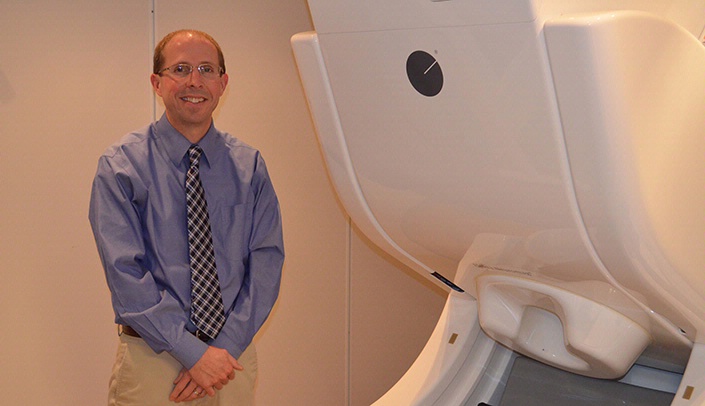How aging affects cognition in HIV-infected patients has been the focus of a three-year interdisciplinary research effort led by Tony Wilson, Ph.D., and Susan Swindells, M.B.B.S.
Now, with the help of a $2.2 million, five-year R01 grant received in 2014 by Dr. Wilson from the National Institutes of Health, they have expanded their efforts to understanding how HIV affects that aging process and what might be done early on to decrease the risk that people with HIV will develop cognitive impairments. Dr. Wilson is associate professor of pharmacology/experimental neuroscience and neurological sciences.
“One of the problems with this cognitive impairment is that it’s very difficult to measure,” said Dr. Swindells, the HIV Clinic Medical Director. “It’s difficult to see what’s going on in the brain. Studies with autopsies have been done, but those are challenging.”
The magnetoencephalography (MEG) scanner in Dr. Wilson’s laboratory is capable of charting brain function in HIV-infected patients (and healthy controls), offering an exploratory avenue that has been paying dividends for the scientists’ collaboration.
“Originally, we were looking at how aging affects brain function in HIV-infected patients, focusing on older patients,” Dr. Wilson said. “Getting this large grant allowed us to look at the whole aging process. Now we are recruiting more than 200 participants who are from age 22 to 76.”
Dr. Swindells said the team drew on a grant that Howard Fox, M.D., Ph.D., received for his Chronic HIV Infection and Aging in NeuroAIDS (CHAIN) Center for the initial work, which in turn led to Dr. Wilson being awarded this new grant.
The clinical application will be to re-scan the same individuals using the MEG to see if brain function has degenerated, improved or stayed the same.
“The problem is there’s no good biomarker,” Dr. Swindells said. “We need a way to measure this process, not only to stage it in an individual patient, but also to look at treatment response and, for clinical trials, to see if a treatment is successful. We need some way to measure, ‘Is this working or not?’ That’s the area where the MEG may have an important role.”
Dr. Swindells’ skills as a clinician and a researcher have been integral to the project, Dr. Wilson said. “Dr. Swindells and I have very different expertise,” he said. “She knows a lot about HIV infection and has studied the epidemic since it first began. She has just been phenomenal in explaining how HIV infection works and the key issues involved. She had a huge role in mentoring me into a higher-level scientist, a more mature scientist.
“We also have had a great participation rate from Dr. Swindells’ patients and community volunteers,” he said. “The community plays a major role in the success of studies like this, and so far we have had many healthy adults volunteer to be in the study as controls. The MEG is totally harmless, and they seem to find the experience totally fascinating.”
Web extra
Read more about the study.
